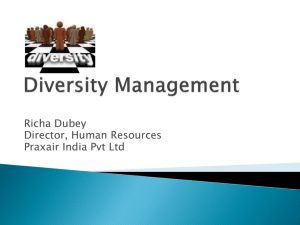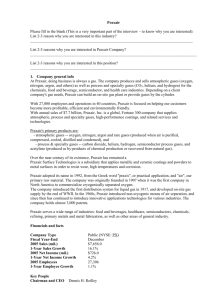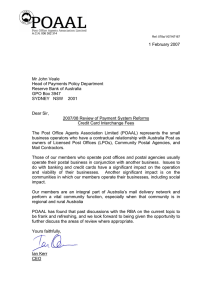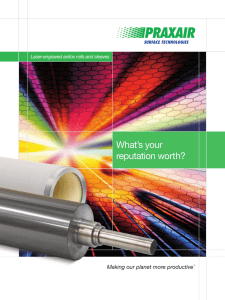Ashleigh Wright Lucas Raney Marshall Lester Michael Greene
advertisement
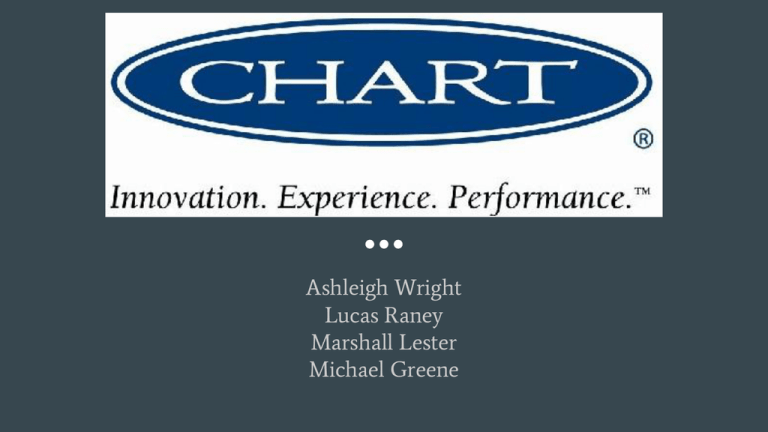
Ashleigh Wright Lucas Raney Marshall Lester Michael Greene Introduction to Chart Industries ● “You may never use the products we make, but everyone uses the products we make possible.” ● Corporate headquarters in US: Garfield Heights, Ohio ○ ● Chart is a recognized global brand. ○ ● 15 locations in the United States including its AirSep, CAIRE and Q-Drive headquarters Has locations in North America, Europe, Asia and Australia, including Columbia, China, Japan, Malaysia, Australia, the Czech Republic, Germany, Italy, Luxembourg, and the UK Distribution, Storage Products, and Engineered Systems. Serving Multiple Industries ● Industrial Gas ○ ● Life Sciences ○ ● CAIRE respiratory products Manufacturing/Fabrication ○ ● MVE biological storage systems Healthcare ○ ● Oxygen, Nitrogen, LNG Tanks for Storage/Transportation Cryogenics ○ Cryochamber History of Chart Industries ● Founders Charles and Arthur Holmes began in 1986 when they purchased ALTEC International, a brazed aluminum heat exchanger manufacturer based in La Crosse, Wisconsin. ● After acquiring multiple companies focused in cold temperature processing, they established Chart Industries in 1992. ● In the early 90’s they continued to acquire multiple Cryogenic specialized companies throughout the U.S. History of Chart Industries ● In the late 1990’s Chart began pushing for international growth. ● Acquired Industrial Heat Exchanger division of UK-based IMI Marston in 1998. ● Also acquired Czech Republic-based Ferox, and CAIRE in 1998. ○ CAIRE is a small business specializing in liquid respiratory oxygen equipment. This formed the base for Chart’s entrance in the healthcare industry. History of Chart Industries ● In 2001, Chart shipped the first LNG refueling station to China. ● In 2005, they built a new facility in Changzhou, China which tripled their manufacturing capabilities in China. ● In 2013, Chart exceeded 1 billion dollars in sales. ● Chart has domestic operations located in eight US states, and internationally in Australia, China, the Czech Republic, Germany and the United Kingdom. Chart Industries Executive Panel Chart Industries Board of Directors Chart’s Top Competitors ● Matrix Service Company ○ ○ ● PRAXAIR INC. ○ ○ ● Praxair Inc. is headquartered in Danbury, Connecticut, with Global locations throughout North America, South America, Europe, and Asia. Praxair is publicly traded in the NYSE with the symbol PX. Linde AG ○ ○ ➢ Matrix Service Company is headquartered in Tulsa, Oklahoma, with subsidiary offices located throughout the United States and Canada, as well as Sydney, Australia and Seoul, South Korea. Matrix Service Company is publicly traded under the NASDAQ symbol MTRX Linde is headquartered out of Munich, Germany, with locations in the U.S., Australia, Africa, and throughout Europe and Asia. Linde is publicly traded in the Frankfurt Stock Exchange with the symbol LIN. Though these companies are listed as competitors in some markets, they are also customers buying storage tanks, services, and products from Chart. Chart Industries Marketing Strategy ● A global company which utilizes a mixed marketing system for its wide array of products: ● Direct-to-distributor platform for its medical oxygen systems ● Business-to-business system for its industrial products and smaller gas storage as well as retail/lab gas delivery systems Competitor’s Marketing Strategies ● Matrix Service Group: ○ ○ ● ● Business-to-business with marketing teams; large scale industrial gas storage and delivery only North America based, has projects worldwide, including Australia and South Korea PRAXAIR INC.: ○ Primarily business-to-business sales utilizing its own distributorship system and online sales for gas delivery and ○ ○ reordering, also utilizes sales offices across the US US based, has offices in 50 countries worldwide Acts as a distributor for Chart MVE gas storage systems Linde AG: ○ ○ Business-to-business, sales teams distributed by industry; modular business systems Global corporation, offices in every continent Charts Growth Strategies ● Chart’s main factor of growth for their Distribution and Storages comes from acquisitions. ● Getting into foreign markets (China, Europe) ● Purchasing companies offering equipment, systems and technology innovators. Competitor’s Focus ● Matrix ○ ● Praxair ○ ● Storage Solutions; Oil Gas & Chemical; Industrial; and Electrical Infrastructure. On-site; Merchant; Packaged Gas Supply Linde AG ○ Industrial Gases and Healthcare; Engineering. Industry Factors ● Economic Factors ○ ○ ○ ● Political Factors ○ ○ ● When the economy is not doing well, neither is Chart. In 2014 when the energy market was done cost were cut and headcount reduced by 21%. Chart was very invested in the oil industry. Government has regulations on pollution a manufacturing plant can have. Green Interest Groups opposition. Social Factors ○ ○ ○ ○ ○ ○ Flexible and relaxed work culture. All about innovation. Values a healthy work-life balance. Very diverse. (Race,Gender, Age) Recent downturn has led to low company morale Top-level management giving no direction. Industry Factors ● Technological Factors ○ ○ ● Product life cycles last more than 3 years. Rate of technological development is very slow. Geographical Factors ○ ○ ○ ○ Headquartered out of Garfield Heights, Ohio. Have 15 different factories located in the United States A lot of business coming from foreign countries. Factories and Sales Offices running through Germany, Italy, Australia, and Asia, Sales Graph Gross Profit Margin Margin ● ● Looking at the margin percentages are easier because two of the companies (Praxair and Linde AG) are so much larger than Matrix and Chart As you can see from the graph, Chart has a high gross profit margin for such a small company Profits Before Taxes and Interest Zoomed In Fall in Profits ● The drop in profits as stated by Chart in their shareholder letter was because of… ○ The loss of value in Chart’s goodwill ○ The drop in the oil industry which Chart was highly involved in Return on Assets Conclusion of the Financials ● ● ● ● Chart is not the best company to invest in right now If Chart cannot bounce back from the oil plunge, it will continue to lose money Chart is involved in many different types of products Chart will be working on investing in other areas of the market now that oil has taken a plunge Chart Industries SWOT Analysis ● Strengths: ○ ○ ○ ○ ● Weaknesses: ○ ○ ○ ● Productivity is suffering Competitive market High level of capital in research and development Opportunities: ○ ○ ● Globally oriented, moving quickly into China Excellent at absorbing other businesses High growth rate Barriers of entry for potential competitors Future acquisitions New products and services Threats: ○ ○ ○ Government regulations Increasing interest rates on loans Increasing labor costs Matrix Service Company SWOT Analysis ● Strengths: ○ ○ ○ ● Weaknesses: ○ ○ ● Focused only on large-scale solutions Economic downturn Opportunities: ○ ○ ● Highly diversified Sales very partnership-based, equals easy relationships with businesses and buyers Vast resources for expansion and growth Smaller scale operations Continued growth and expansion into new markets Threats: ○ ○ Economic downturn caused issues, continuously low oil prices results in little business Government regulations Praxair SWOT Analysis ● Strengths ○ ○ ○ ● Weaknesses ○ ○ ● Weak cash flow system Many lawsuits from violating certain environmental regulations. Opportunities ○ ○ ○ ● Geographic presence in over 50 different countries. Tremendous top-line performance with increasing overall revenue growth. Wide business portfolio - Not Defined to one product Emerging into the Asia-Pacific regions. New contracts with suppliers in the North American Belt. Cost Advantage Threats ○ ○ Environmental Regulations Foreign Exchange Risk Linde Ag SWOT Analysis ● Strengths ○ ○ ○ ● Weaknesses ○ ○ ○ ● Highly affected by changes in the economy. High Production cost Debt Opportunities ○ ○ ● Large range of industrial gases and applications making them very diverse. Pioneering in safety measures. Focus deeply on well-trained employees. Can offer alternatives to toxic solvents. Has the potential to become cost efficient through modular and hardware footprints. Threats ○ ○ Customers would rather be using shale gas and by-products. Decrease in production margins.
